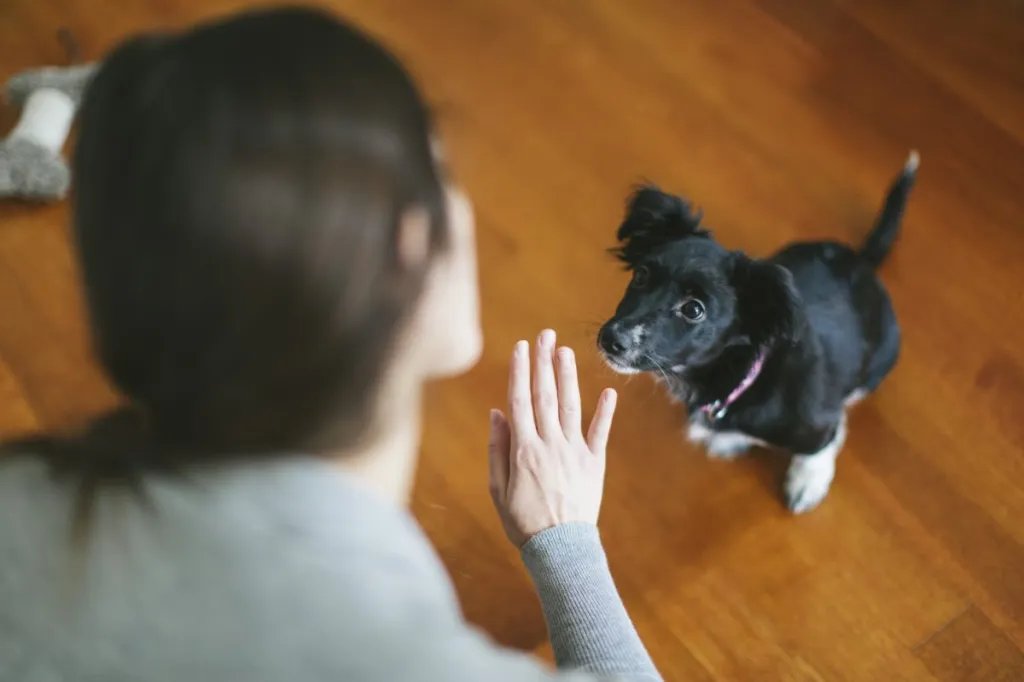“Sit” is one of the simplest commands, but it’s incredibly useful — after all, your dog can’t jump all over a guest, dash into traffic, or do any number of things you don’t want them to do when they’re sitting.
How to teach “sit” with a food lure from a standing position
This method uses a food treat or piece of kibble both to lure your dog into the sitting position and to reward them for responding to the command. If your dog isn’t very motivated by food, you can use a favorite toy in place of the treat.
- Slowly move the treat from just in front of your dog’s nose, then up and back over their muzzle to between their eyes. Keep the treat just an inch or so away from your dog the whole time. As your dog’s head tilts up to follow the treat, their rear end should automatically go down.
- As soon as your dog’s butt hits the ground, praise them and give them the treat.
- Repeat the exercise several times.
- Once your dog gets the hang of it, introduce the verbal cue: Tell them “sit” just before you move the treat from in front of their nose to above their head.
- Once your dog starts to respond reliably, begin to offer treats sporadically, only for the quickest, crispest sits. Eventually, you can phase out food treats entirely.
If it’s not working
Your dog jumps up: You’re holding the food lure too high. Try again with the food just an inch above your dog’s head.
Your dog backs up: You may be moving the treat too far back over your dog’s head. Instead, aim for between their eyes. If that doesn’t work, you can try putting your dog in a corner when you practice the “sit” command.
How to teach “sit” with a food lure from a down position
- With your dog lying down, quickly move the food lure up and back over their muzzle, starting from in front of their nose and moving toward their eyes.
- As your dog’s head goes up to follow the treat, they should rise into a sitting position. Praise them as soon as their butt hits the floor, and reward them with the treat.
- Repeat the exercise several times.
- Once your dog gets the hang of it, introduce the verbal cue. Tell your dog to “sit” just before you move the treat from in front of their nose to above their head.
- When your dog starts to respond reliably, begin to offer treats sporadically, only for the quickest, crispest sits. Eventually, you can phase out food treats entirely.
If it’s not working
Your dog doesn’t sit up: Your pup may not realize the treat is there. Try waggling the treat or clapping your hands to get their attention.
Your dog rolls over onto their back. If you take one step back and pat the ground in front of your dog’s nose, they’ll probably roll back onto their stomach. As soon as they’re on her tummy, move the lure from in front of their nose to between their eyes to get them to rise into the sitting position.
How to teach “sit” with an alternate method
Whenever you’re around your dog and see them start to sit, tell them “sit.” As soon as their rear end hits the floor, praise them and reward them with an ear scratch, tummy rub, or a treat if you have one on hand. They’ll soon begin to associate the word “sit” with the action.
Advanced “sit”
Once your dog has the hang of the “sit” command, you can slowly make it more challenging. Ask your dog to sit when:
- You are 1 foot away from your dog
- You are 2 feet away from your dog
- Your back is turned
- When there’s another person or dog in the distance
- When there’s another person or dog close by
- When there’s another person or dog right next to your dog
- When you’re bouncing a ball
- When there’s kibble scattered around her
Add a new challenge only if your dog is responding reliably. If your dog gets confused, take away the challenge and try again, moving more slowly this time.









